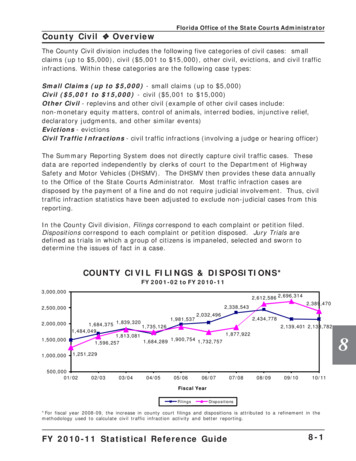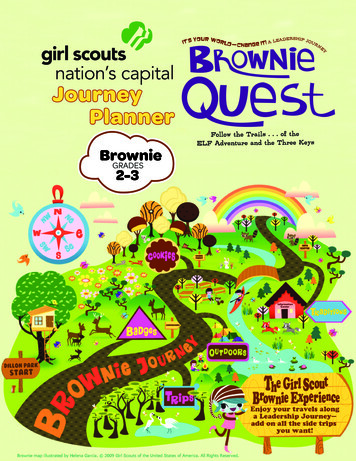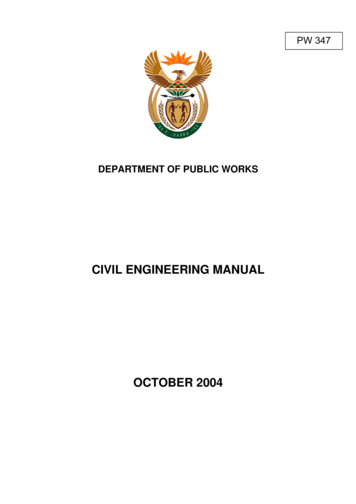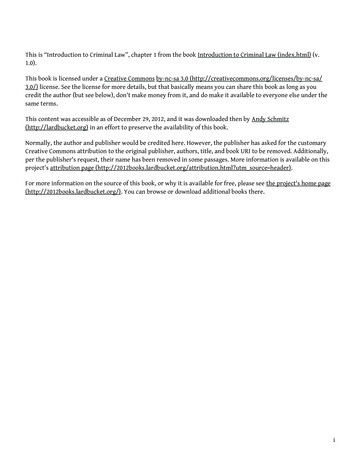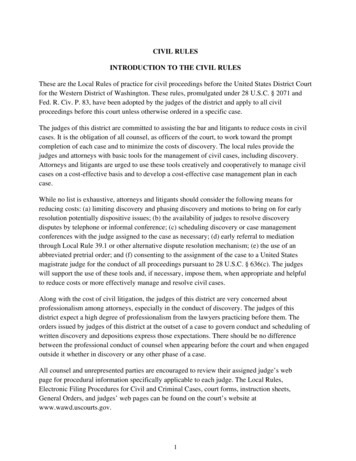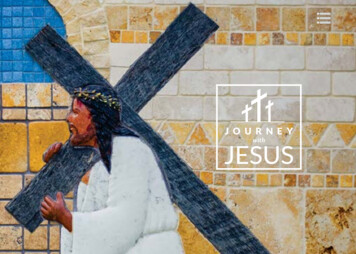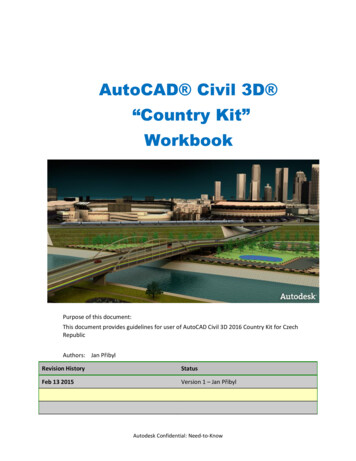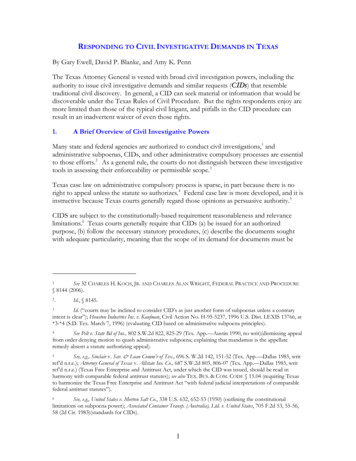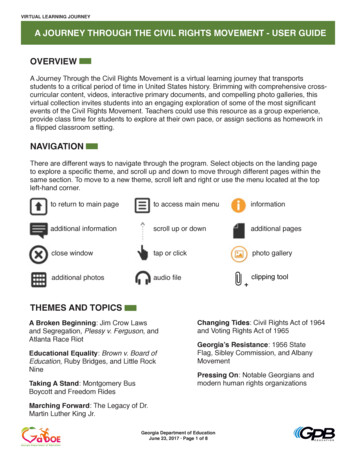
Transcription
VIRTUAL LEARNING JOURNEYA JOURNEY THROUGH THE CIVIL RIGHTS MOVEMENT - USER GUIDEOVERVIEWA Journey Through the Civil Rights Movement is a virtual learning journey that transportsstudents to a critical period of time in United States history. Brimming with comprehensive crosscurricular content, videos, interactive primary documents, and compelling photo galleries, thisvirtual collection invites students into an engaging exploration of some of the most significantevents of the Civil Rights Movement. Teachers could use this resource as a group experience,provide class time for students to explore at their own pace, or assign sections as homework ina flipped classroom setting.NAVIGATIONThere are different ways to navigate through the program. Select objects on the landing pageto explore a specific theme, and scroll up and down to move through different pages within thesame section. To move to a new theme, scroll left and right or use the menu located at the topleft-hand corner.to return to main pageto access main menuinformationadditional informationscroll up or downadditional pagesclose windowtap or clickphoto galleryadditional photosaudio fileclipping toolTHEMES AND TOPICSA Broken Beginning: Jim Crow Lawsand Segregation, Plessy v. Ferguson, andAtlanta Race RiotEducational Equality: Brown v. Board ofEducation, Ruby Bridges, and Little RockNineTaking A Stand: Montgomery BusBoycott and Freedom RidesChanging Tides: Civil Rights Act of 1964and Voting Rights Act of 1965Georgia’s Resistance: 1956 StateFlag, Sibley Commission, and AlbanyMovementPressing On: Notable Georgians andmodern human rights organizationsMarching Forward: The Legacy of Dr.Martin Luther King Jr.Georgia Department of EducationJune 23, 2017 · Page 1 of 8
VIRTUAL LEARNING JOURNEYA JOURNEY THROUGH THE CIVIL RIGHTS MOVEMENT - USER GUIDEDISCUSS1. Why was Plessy v. Ferguson such an important case for the South, and what effect did ithave on the practice of segregation?2. What were some of the catalysts for the Atlanta Race Riot? Why was it considered ashameful occurrence for the city of Atlanta?3. How does the Brown v. Board of Education decision stand in direct contrast to the previous“separate but equal” legal doctrine?4. What emotions do you imagine that Ruby Bridges and the Little Rock Nine felt whenattempting to integrate public schools in the South? Which emotions helped these children andyouth persevere in their fight for educational equality?5. Which piece of artwork interests you the most and why?6. Explain the motivations and roles of two different advocacy organizations involved in the CivilRights Movement.7. What was the purpose of the Freedom Rides? Why did the Nashville group choose tocontinue the rides after they had been canceled due to violence?8. Describe some of the major events that Dr. Martin Luther King Jr. attended. What was theoverlying purpose for each event and how did he support that purpose?9. To what degree did the actions and beliefs of individual activists, such as Rosa Parks andJohn Lewis, drive the momentum of the Civil Rights Movement as a whole?10. What is the difference between human and civil rights? Provide examples of each.Georgia Department of EducationJune 23, 2017 · Page 2 of 8
VIRTUAL LEARNING JOURNEYA JOURNEY THROUGH THE CIVIL RIGHTS MOVEMENT - USER GUIDEEXTEND1. Using the clipping feature ( ) to capture documents, pictures, and additional materials fromthis learning journey, compile a reflective journal with your thoughts and feelings on the eventsthat occurred during the Civil Rights Movement. You could use a free online journaling tool likePenzu or Seesaw.2. Using the “Marching Forward” section of the virtual learning experience and Unit 8, Chapter20 of the Georgia Studies Book: Our State and Our Nation, have students complete a “BodyBiography” after reading either Dr. Martin Luther King’s “Letter from Birmingham Jail” (p. 546)or “I Have a Dream” speech (p. 555). They will first draw or trace the outline of a body, thenanswer specific questions within each body part as detailed below.HeadExplain the speaker’s thoughts at the time.EyesHow does the speaker view his surroundings or situation?HeartHow would you describe the speaker’s purpose and goals?HandsWhat does the speaker hold or feel? Why?FeetHow would you describe the speaker’s principles or values?3. Propose an organization that advocates for a social cause you consider important. Nameyour organization, create a meaningful logo, and identify three main goals. Explain why theseissues are significant and what could be done to raise awareness among your peers.4. Many times, the lyrics of freedom songs were adapted from older spirituals and changedto reflect more recent events. Take one of the freedom songs provided in this virtual learningexperience, and change the lyrics so that they reflect the happenings of a current issue that isimportant to you.DOCUMENT-BASED QUESTIONHow has the debate about Georgia’s flag changed over time? Use the excerpted primarysources below to answer the question.BACKGROUND: In 1955, a campaign was initiated to replace the red and white bars of thestate flag with the “Southern cross” Confederate battle emblem. Legislation to change the flagwas soon introduced in Georgia’s General Assembly and passed in 1956. Many believed thechange was a timely way to commemorate the approaching centennial of the Confederacy.However, one of the major catalysts for the flag’s makeover was opposition to the SupremeCourt’s ruling in Brown v. Board of Education.More than 50 years later, Governor Roy Barnes submitted a new design to the GeneralAssembly, which was passed in 2001. Many supporters of the 1956 version of the flag wereoutraged, and in 2004, a statewide referendum was held that allowed Georgians to votebetween a newly designed flag and the 2001 version. There was no option to select the 1956flag. Seventy-three percent of voters chose the new design.Martinez, M. (2008). The Georgia Confederate Flag Dispute. Georgia Historical Quarterly, 92, 200-228.Georgia Department of EducationJune 23, 2017 · Page 3 of 8
VIRTUAL LEARNING JOURNEYA JOURNEY THROUGH THE CIVIL RIGHTS MOVEMENT - USER GUIDE1920 - 19561956 - 20012001 - 20042004 - PresentDOCUMENT A: Governor Marvin Griffin, State of the Address (1956)There will be no mixing of the races in the public schools and college classrooms of Georgiaanywhere or at any time as long as I am governor . All attempts to mix the races, whether theybe in the classrooms, on the playgrounds, in public conveyances or in any other area of closepersonal contact on terms of equity, peril the mores of the South. The tragic decision of theUnited States Supreme Court on May 17, 1954, poses a threat to the unparalleled harmonyand growth that we have attained here in the South for both races under the frameworkof established customs. Day by day, Georgia moves nearer a showdown with this FederalSupreme Court – a tyrannical court ruthlessly seeking to usurp control of state-created, statedeveloped, and state-financed schools and colleges. The next portent looming on the horizonis a further declaration that a State’s power to prohibit mixed marriages is unconstitutional.Griffin, M. S. (1956, January 10). State of the State Address [transcript]. ts/00StateFlag.pdfDOCUMENT B: Resolution of Georgia General Assembly be it further resolved by the House of Representatives, the Senate concurring:First: That said decisions and orders of the Supreme Court of the United States relating toseparation of the races in the public institutions of a State as announced and promulgated bysaid court on May 17, 1954, and May 31, 1955, are null, void and of no force or effect;Second: That hereby there is declared the firm intention of this State to take all appropriatemeasures honorably and constitutionally available to the State, to avoid this illegalencroachment upon the rights of her people;Third: That we urge upon our sister States firm and deliberate efforts upon their part to checkthis and further encroachment on the part of the General Government, and on the part of saidcourt through judicial legislation, upon the reserved powers of all the States, that by unitedefforts the States may be preserved;Georgia Department of EducationJune 23, 2017 · Page 4 of 8
VIRTUAL LEARNING JOURNEYA JOURNEY THROUGH THE CIVIL RIGHTS MOVEMENT - USER GUIDEFourth: That a copy of this resolution be transmitted by His Excellency the Governor to theGovernor and legislature of each of the other States, to the President of the United States, toeach of the Houses of Congress, to Georgia’s Representatives and Senators in the Congress,and to the Supreme Court of the United States for its information.Georgia General Assembly. [Interposition Resolution]. No. 130 (House Resolution No. 185). (1956). Retrieved fromGeorgiaInfo.DOCUMENT C: North Georgia Tribune Newspaper (1956) we can’t help but believe that [the new flag] will carry the state back a little nearer the CivilWar. There is little wisdom in a state taking an official action which would incite its people tolose patriotism in the U.S.A. or cast a doubt on that part of the Pledge of Allegiance which says‘one nation, unto God, indivisible.’ So far as we are concerned, the old flag is good enough.We dislike the spirit which hatched out the new flag, and we don’t believe Robert E. Lee would like it either.North Georgia Tribune (1956, February 26) Editorial. Atlanta Sunday Journal-Constitution. Retrieved from ts/00StateFlag.pdfDOCUMENT D: Former Georgia Legislator Denmark Groover’s Address to Georgia House ofRepresentativesI cannot say to you that I personally was in no way motivated by a desire to defy. I can say in allhonesty that my willingness was in large part because . that flag symbolized a willingness of apeople to sacrifice their all for their beliefs.Groover, D. (1993, March 10). Address to Georgia House of Representatives [transcript] Retrieved from ts/00StateFlag.pdf.Georgia Department of EducationJune 23, 2017 · Page 5 of 8
VIRTUAL LEARNING JOURNEYA JOURNEY THROUGH THE CIVIL RIGHTS MOVEMENT - USER GUIDEDOCUMENT E: Governor Roy Barnes’s Address to Georgia State SenateMy great-grandfather was captured at Vicksburg fighting for the Confederacy, and I still visithis grave in the foothills of Gilmer County. I am proud of him. But I am also proud that we havecome so far that my children find it hard to believe that we ever had segregated schools orseparate water fountains labeled “white” and “colored.” And I am proud that these changescame about because unity prevailed over division. Today, that same effort and energy of unitymust be exercised again. The Confederate Battle Flag occupies two-thirds of our current stateflag. Some argue that it is a symbol of segregation, defiance, and white supremacy. Others thatit is a testament to a brave and valiant people who were willing to die to defend their homes andhearth. I am not here to settle this argument – because no one can – but I am here because it istime to end it.Barnes, R. (2001, January 24). Address to the Georgia State Senate [transcript]. Retrieved from ch.shtml#.WUP BhjMwk8.DOCUMENT F: Speech of Governor Zell MillerThe South is the fastest growing area of the country. And our growing dominance in nationalleadership reflects our growing prominence in the world economy. Yet at the very time when allsoutherners may rightly take pride in the region’s current success, some Georgians persist inbelieving that the pride of the South is better defined by a symbol of defiance and intolerance –the Confederate Battle Flag, which was imposed on our state flag in 1956 . You may quibbleall you want about who said what in 1956. It is clear the flag was changed in 1956 to identifyGeorgia with the dark side of the Confederacy – that desire to deprive some Americans of theequal rights that are the birthright of all Americans .Miller, Z. (1993, January 12). State of the State Address [transcript]. In C. Meyers. (Ed.), The Empire State of theSouth: Georgia History in Documents and Essays (332-333). Macon, GA: Mercer University Press.ADDITIONAL RESOURCES1. Georgia Stories: The Alonzo Herndon Family2. Georgia Stories: The Race Riot of 19063. Georgia Stories: The Beat of Civil Rights4. Georgia Stories: Civil Rights in the Classroom5. Georgia Stories: The Economic Aspects of the Civil Rights MovementGeorgia Department of EducationJune 23, 2017 · Page 6 of 8
VIRTUAL LEARNING JOURNEYA JOURNEY THROUGH THE CIVIL RIGHTS MOVEMENT - USER GUIDEGEORGIA STANDARDSDue to the graphic nature of some of the testimonials, photos, and videos, we recommend previewing content for youngerlearners.SECOND GRADESS2H1: Describe the lives and contributions of historical figures in Georgia history.a. Martin Luther King, Jr. (civil rights)FOURTH GRADESS4H6: Analyze the effects of Reconstruction on American life.a. Describe the purpose of the 13th, 14th, and 15th Amendments.c. Explain how slavery was replaced by sharecropping and how freed AfricanAmericans or Blacks were prevented from exercising their newly won rights.d. Describe the effects of Jim Crow laws and practices.FIFTH GRADESS5H6: Describe the importance of key people, events, and developments between 1950-1975.a. Analyze the effects of Jim Crow laws and practices.b. Explain the key events and people of the Civil Rights movement: Brown v. Board ofEducation (1954), Montgomery Bus Boycott, March on Washington, Civil Rights Act,Voting Rights Act, and civil rights activities of Thurgood Marshall, Lyndon b. Johnson,Cesar Chavez, Rosa Parks, and Martin Luther King, Jr.EIGHTH GRADESS8H6: Analyze the impact of Reconstruction on Georgia.a. Explain the roles of the 13th, 14th, and 15th Amendments in Reconstruction.d. Examine reasons for and effects of the removal of African American or blacklegislators from the Georgia General Assembly during Reconstruction.SS8H7: Evaluate key political, social, and economic changes that occurred in Georgia duringthe New South Era.b. Analyze how rights were denied to African Americans or blacks through Jim Crowlaws, Plessy v. Ferguson, disenfranchisement, and racial violence, including the 1906Atlanta Riot.c. Explain the roles of Booker T. Washington, W.E.B. Du Bois, and Alonzo Herndon inadvancement of the rights of African Americans or blacks in the New South Era.SS8H11: Evaluate the role of Georgia in the modern civil rights movement.a. Explain Georgia’s response to Brown v. Board of Education including the 1956 flagand the Sibley Commission.b. Describe the role of individuals (Martin Luther King, Jr. and John Lewis), groups(SNCC and SCLC) and events (Albany Movement and March on Washington) in theCivil Rights Movement.c. Explain the resistance to the 1964 Civil Rights Act, emphasizing the role of LesterMaddox.SS8H12: Explain the importance of developments in Georgia since the late 20th century.a. Explain how the continued development of Atlanta under mayors Maynard Jacksonand Andrew Young impacted the state.Georgia Department of EducationJune 23, 2017 · Page 7 of 8
VIRTUAL LEARNING JOURNEYA JOURNEY THROUGH THE CIVIL RIGHTS MOVEMENT - USER GUIDEAMERICAN GOVERNMENT/CIVICSSSCG7:Demonstrate knowledge of civil liberties and civil rights.b. Define civil rights as equal protections for all people (e.g., Civil Rights Act,Brown v. Board of Education, etc.)US HISTORYSSUSH10: Identify legal, political, and social dimensions of Reconstructionc. Describe the significance of the Thirteenth, Fourteenth, and Fifteenthamendments.d. Explain the Black Codes, the Ku Klux Klan, and other forms resistance toracial equality during Reconstruction.SSUSH13: Evaluate efforts to reform American society and politics in the Progressive Erac. Connect the decision of Plessy v. Ferguson to the expansion of Jim Crowlaws and the formation of the NAACP.SSUSH20: Analyze the U.S. International and domestic policies including their influenceson technological advancement and social changes during the Truman andEisenhower administrations.b. Connect major domestic issues to their social effects including the G.I. Bill,Truman’s integration policies, McCarthyism, the National Interstate and DefenseHighways Act, and Brown v. Board of Education.SSUSH21: Analyze U.S. international and domestic policies including their influenceson technological advancements and social changes during the Kennedy andJohnson administrations.b. Connect major domestic issues to their social effects including the passage ofcivil rights legislation and Johnson’s Great Society, following the assassination ofJohn F. Kennedy.d. Investigate the growth, influence, and tactics of civil rights groups, MartinLuther King, Jr., the Letter from Birmingham Jail, the I Have a Dream Speech,and Cesar Chavez.Georgia Department of EducationJune 23, 2017 · Page 8 of 8
same section. To move to a new theme, scroll left and right or use the menu located at the top left-hand corner. to return to main page to access main menu information additional information scroll up or down additional pages close window tap or click photo gallery additional photos audio file. THEMES AND TOPICS




